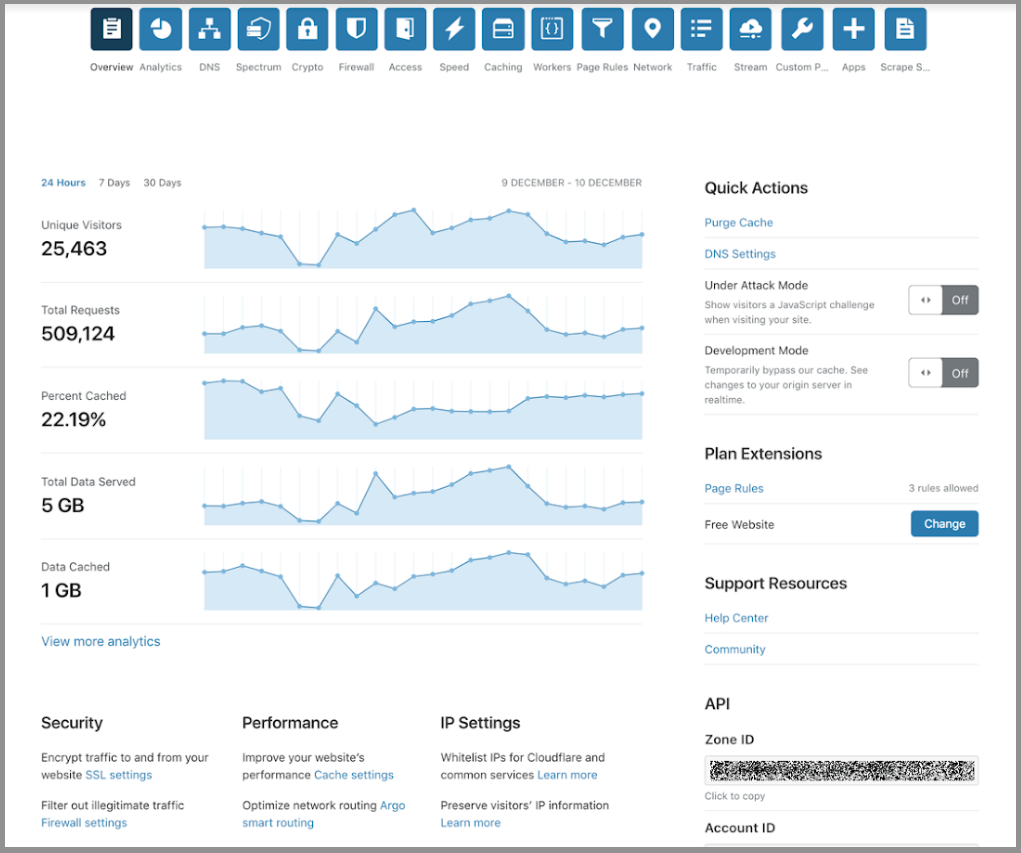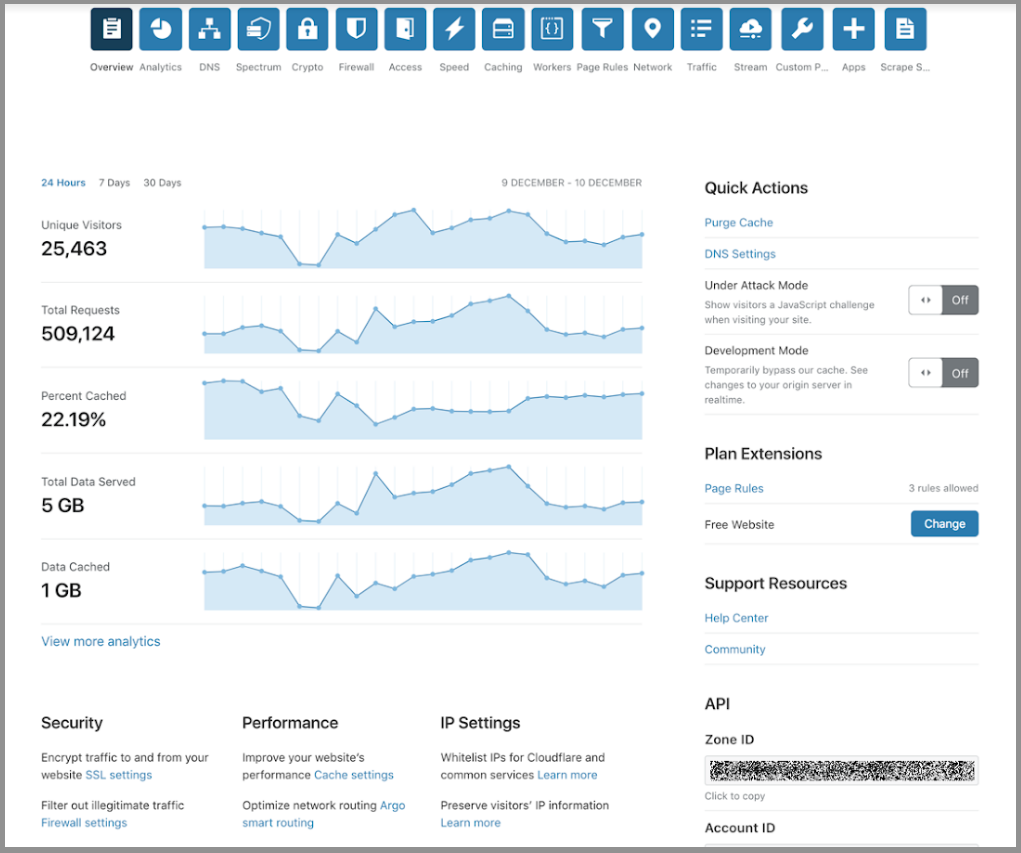The truth about Black Friday and Cyber Monday

At Cloudflare we handle a lot of traffic on behalf of our customers. Something we all see and hear a lot about at this time of year are Black Friday (23 November this year) and Cyber Monday (26 November) - but just how important are these days on the Internet?

To try and answer this question, we took a look at anonymised samples of HTTP requests crossing our network. First of all, let’s look at total page views from across our global network from the last few weeks and see if we can spot Black Friday and Cyber Monday:

So this is total page views by day (UTC) from November 19 (a week before Cyber Monday) until Monday December 3. Other than follow-the-sun fluctuations in a repeating daily pattern, each whole day is pretty similar in shape and size compared to the last. Black Friday and Cyber Monday aren’t visible in overall traffic patterns.
Get specific
We have a very diverse set of customers across 12 million domain names and not all of them are selling products or doing so directly online. To identify those websites Continue reading
Building Your Own Virtual Lab
Last week we published Matt Oswalt’s thoughts on using virtual labs in training and testing. In the second part of his interview with Christoph Jaggi he talked about building a virtual lab.
Matt will cover the same topic in way more details in his guest speaker presentation in Spring 2019 Building Network Automation Solutions online course. Register here.
Read more ...A new look on your Cloudflare dashboard

Building a great customer experience is a top priority here at Cloudflare. Over the last week, we have been slowly rolling out an improvement to our customer dashboard - specifically the zone overview page. We are now ready to share the new dashboard with everyone.

Many of the changes you’ll notice first were driven directly by customer feedback. We’ve heard time and time again that site owners would like better visibility of their key analytics, and for it to be easier to apply certain common settings changes. This new dashboard provides both, with a snapshot of several of your key analytics, and a new toolkit area for easy access to key functions. This page has also been redesigned from top to bottom for responsiveness across various devices and screen widths.
Even more interesting is all the work under-the-hood that went into making this release and how it sets the stage for improvements to our customer experience as we look ahead to 2019. This is one of the first pieces of production Product work shipped using our new prototyping framework. We will soon be sharing details of the design systems work that underlies the new experience on Continue reading
Optanix Launches Monitoring Platform From Internal Software Offering
 “Most software that’s used for monitoring comes from software companies. We built this software out of operational need and we built it as users of the technology,” said Optanix CSO Edmond Baydian.
“Most software that’s used for monitoring comes from software companies. We built this software out of operational need and we built it as users of the technology,” said Optanix CSO Edmond Baydian.
Deutsche Telekom Launches 5G Network in Poland With Huawei Equipment
 Things aren’t all bad news for Huawei. T-Mobile Poland confirmed that Huawei is the sole vendor supporting its 5G network.
Things aren’t all bad news for Huawei. T-Mobile Poland confirmed that Huawei is the sole vendor supporting its 5G network.
VMware Rolls Out NSX Service Mesh Based on Istio
 The NSX Service Mesh beta will initially support Cloud PKS (formerly known as VMware Kubernetes Engine or VKE), but VMware plans to extend it to any Kubernetes environment.
The NSX Service Mesh beta will initially support Cloud PKS (formerly known as VMware Kubernetes Engine or VKE), but VMware plans to extend it to any Kubernetes environment.
Lenovo Works With Cumulus to Offer Disaggregated Switch Hardware, Software
 Cumulus already offers its NOS on lots of different hardware. But this is Lenovo’s first foray into the disaggregated switch model.
Cumulus already offers its NOS on lots of different hardware. But this is Lenovo’s first foray into the disaggregated switch model.
SD-WAN Will Be Fueled By Collaboration Between Cloud Providers and Vendors
 The latest numbers from IHS Markit show that SD-WAN revenue grew 23 percent from the previous quarter to $284 million. VMware continues to hold the No. 1 spot.
The latest numbers from IHS Markit show that SD-WAN revenue grew 23 percent from the previous quarter to $284 million. VMware continues to hold the No. 1 spot.
Optimal Route Reflection: Next Hop Self
Recently, I posted a video short take I did on BGP optimal route reflection. A reader wrote in the comments to that post:
…why can’t Router set next hop self to updates to router E and avoid this suboptimal path?
To answer this question, it is best to return to the scene of the suboptimality—

To describe the problem again: A and C are sending the same route to B, which is a route reflector. B selects the best path from its perspective, which is through B, and sends this route to each of its clients. In this case, E will learn the path with a next hop of A, even though the path through C is closer from E’s perspective. In the video, I discuss several ways to solve this problem; one option I do not talk about is allowing B to set the next hop to itself. Would this work?
Before answering the question, however, it is important to make one observation: I have drawn this network with B as a router in the forwarding path. In many networks, the route reflector is a virtual machine, or a *nix host, and is not capable of forwarding the traffic Continue reading
Pivotal Picks Kubernetes, Knative to Bust Serverless Siloes
 The Pivotal Function Service is the first multi-cloud packaging of the Kubernetes-based Knative project and operates alongside the Pivotal Application Service and Pivotal Container Service.
The Pivotal Function Service is the first multi-cloud packaging of the Kubernetes-based Knative project and operates alongside the Pivotal Application Service and Pivotal Container Service.
Six Reasons Why You Should Consider Unifying Your Multi-Site Data Center Architecture
Data Center Interconnect (DCI) is an architecture for connecting two or more geographically distributed data center locations. Often when one...sFlow to JSON
The latest version of sflowtool can convert sFlow datagrams into JSON, making it easy to write scripts to process the standard sFlow telemetry streaming from devices in the network.Download and compile the latest version of sflowtool:
git clone https://github.com/sflow/sflowtool.gitThe -J option formats the JSON output to be human readable:
cd sflowtool/
./boot.sh
./configure
make
sudo make install
$ sflowtool -JThe output shows the JSON representation of a single sFlow datagram containing one counter sample and one flow sample.
{
"datagramSourceIP":"10.0.0.162",
"datagramSize":"396",
"unixSecondsUTC":"1544241239",
"localtime":"2018-12-07T19:53:59-0800",
"datagramVersion":"5",
"agentSubId":"0",
"agent":"10.0.0.231",
"packetSequenceNo":"1068783",
"sysUpTime":"1338417874",
"samplesInPacket":"2",
"samples":[
{
"sampleType_tag":"0:2",
"sampleType":"COUNTERSSAMPLE",
"sampleSequenceNo":"148239",
"sourceId":"0:3",
"elements":[
{
"counterBlock_tag":"0:1",
"ifIndex":"3",
"networkType":"6",
"ifSpeed":"1000000000",
"ifDirection":"1",
"ifStatus":"3",
"ifInOctets":"4162076356",
"ifInUcastPkts":"16312256",
"ifInMulticastPkts":"187789",
"ifInBroadcastPkts":"2566",
"ifInDiscards":"0",
"ifInErrors":"0",
"ifInUnknownProtos":"0",
"ifOutOctets":"2115351089",
"ifOutUcastPkts":"7087570",
"ifOutMulticastPkts":"4453258",
"ifOutBroadcastPkts":"6141715",
"ifOutDiscards":"0",
"ifOutErrors":"0",
"ifPromiscuousMode":"0"
},
{
"counterBlock_tag":"0:2",
"dot3StatsAlignmentErrors":"0",
"dot3StatsFCSErrors":"0",
"dot3StatsSingleCollisionFrames":"0",
"dot3StatsMultipleCollisionFrames":"0",
"dot3StatsSQETestErrors":"0",
"dot3StatsDeferredTransmissions":"0",
"dot3StatsLateCollisions":"0",
"dot3StatsExcessiveCollisions":"0",
"dot3StatsInternalMacTransmitErrors":"0",
"dot3StatsCarrierSenseErrors":"0",
"dot3StatsFrameTooLongs":"0",
"dot3StatsInternalMacReceiveErrors":"0",
"dot3StatsSymbolErrors":"0"
}
]
},
{
"sampleType_tag":"0:1",
"sampleType":"FLOWSAMPLE",
"sampleSequenceNo":"11791",
"sourceId":"0:3",
"meanSkipCount":"2000",
"samplePool":"34185160",
"dropEvents":"0",
"inputPort":"3",
"outputPort":"10",
"elements":[
{
"flowBlock_tag":"0:1",
"flowSampleType":"HEADER",
"headerProtocol":"1",
"sampledPacketSize":"102",
"strippedBytes":"0",
"headerLen":"104",
"headerBytes":"0C-AE-4E-98-0B-89-05-B6-D8-D9-A2-66-80-00-54-00-00-45-08-12-04-00-04-10-4A-FB-A0-00-00-BC-A0-00-00-EF-80-00-DE-B1-E7-26-00-20-75-04-B0-C5-00-00-00-00-96-01-20-00-00-00-00-00-01-11-21-31-41-51-61-71-81-91-A1-B1-C1-D1-E1-F1-02-12-22-32-42-52-62-72-82-92-A2-B2-C2-D2-E2-F2-03-13-23-33-43-53-63-73-1A-1D-4D-76-00-00",
"dstMAC":"0cae4e980b89",
"srcMAC":"05b6d8d9a266",
"IPSize":"88",
"ip.tot_len":"84",
"srcIP":"10.0.0.203",
"dstIP":"10.0.0.254",
"IPProtocol":"1",
"IPTOS":"0",
"IPTTL":"64",
"IPID":"8576",
"ICMPType":"8",
"ICMPCode":"0"
},
{
"flowBlock_tag":"0:1001",
"extendedType":"SWITCH",
"in_vlan":"1",
"in_priority":"0",
"out_vlan":"1",
"out_priority":"0"
}
]
}
]
}
The Continue reading
The Week in Internet News: Australia Adopts Controversial Encryption Law

Australia vs. encryption: The Australian Parliament has passed a law that requires tech companies to give law enforcement agencies there access to encrypted communications, the New York Times reports. Several tech companies and privacy groups opposed the law, saying it hurts efforts to protect data from hackers. Fortune, which called the law “draconian,” says it will create headaches for large tech companies.
Slow rolling: While several news stories this year talked about quantum computing being an eventual threat to encryption, that possibility is still more than a decade away, according to a report from the U.S. National Academies of Sciences, Engineering, and Medicine. The U.S. may need to invest heavily in quantum computing to retain a global lead in the technology, the report recommends. Nextgov has the story.
Filling the pipes: Botnets of compromised Internet of Things devices make up more than three quarters of the malware on communication service provider networks this year, up from 33 percent of the malware in 2016, Infosecurity reports. Hackers are increasingly targeting IoT devices instead of PCs and other traditional systems.
Blockchain tackles phishing: A company called MetaCert wants to use blockchain to help fight the scourge of phishing emails, Wired. Continue reading
Introducing VMware NSX Service Mesh
Introducing VMware NSX Service Mesh
We are excited to introduce VMware NSX® Service Mesh. Built on the foundation of Istio, this VMware offering will extend the capabilities of the Istio service mesh technology to bring visibility, control, and security at the application layer to microservices, the data they access, the users that interact with them, as well as traditional monolithic applications. In short, NSX Service Mesh will enable visibility, control, and security for services, data, and users at the API level. This acts as a natural evolution of cloud-native constructs and will act as an extension of the NSX-T Data Center platform’s replication of networking and security services in software, which is applied directly to containers via the Container Network Interface (CNI).

The Rise of Microservices
With the rise of cloud-native architectures built on distributed microservices, developers are encountering challenges with visibility, management, and control of these new applications. The microservices that these apps are comprised of are developed on cloud-native platforms like Kubernetes or Cloud Foundry, using a variety of programming languages, and often across multiple cloud environments. In addition, these applications consist of many more endpoints to scale, secure, and monitor than in traditional ones. This ultimately Continue reading
Troubleshooting Basic MPLS L3VPN – Part 2 – MPLS
Ready for part 2 of our Network Detective MPLS L3VPN Ride-Along? In part 1 we were presented with the “Case of the Failed L3VPN Ping”. We started, like any ping troubleshooting, on the IP subnets themselves – do they exist in the... Read More ›
The post Troubleshooting Basic MPLS L3VPN – Part 2 – MPLS appeared first on Networking with FISH.
15 Top Companies for IT Job Postings
You might be surprised by how few of the top tech employers are in the technology industry.